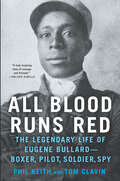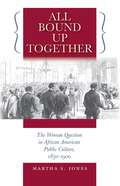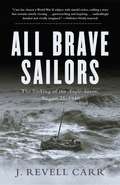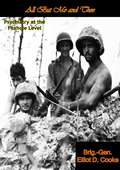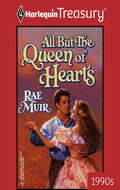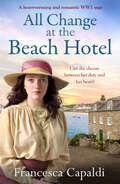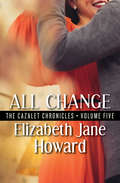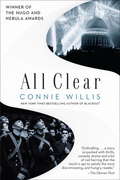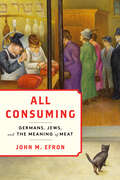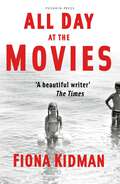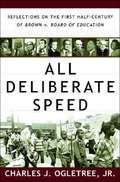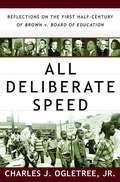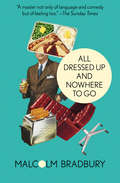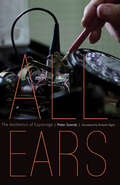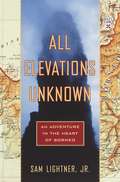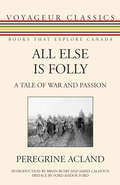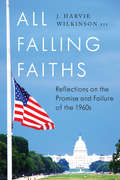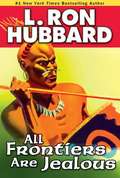- Table View
- List View
All Around the Ton: 5 Regency Romances
by Elizabeth BoyceWelcome to London's high society, where dukes and earls are worth their weight in gold and pearls. But prim and proper behavior isn't always so easy when hearts are involved. From the ballrooms to the gaming hells, these five Regency couples are turning the ton on its ear with their scandals and secrets.Once an Heiress: Well-known rogue Ethan Helling is over his ears in gambling debts and must marry a fortune. Enter Lily Bachman with the largest dowry the haute ton has seen in years and zero interest in marriage. But when the seducer becomes the seduced, Lily and Ethan are forced into a hasty union. Now, to gain her fortune, Ethan must find a way to make his unwilling bride happy.Once Upon a Scandal: Caught in a scandal of her father's making, Jane is an outcast in the society that once prized her refinement. Can Lord Benjamin Marworth, whose reputation as a rake conceals his role as a spy for the Crown, save both England and Jane by faking her death and reincarnating her as a French cousin who can ferret out the stolen war secrets he needs? It's a proposition steeped in scandal if they're caught--but love just might be worth the risk.Merry's Wonderful Christmas Gift: The winter holidays used to be Miss Merry Damonson's favorite time of year. Until her almost-fiancé Edward Everton abandoned her two days before Christmas. Now he's returned to their country village, but is it too late to reignite old flames? A holiday ball might just offer these unlucky lovers a second chance.The Glass Orchid: Determined to take charge of her own fate, orphan Adel Beaumont pursues the only means to an independent life available to her: become a courtesan to wealthy and powerful men. Twenty-one-year-old Rhys Camden is his father's answer to increasing the family's social standing to match their newfound wealth. When Adel and Rhys's lives entwine, they vow to defy society and family and risk everything to be together. But they soon learn how dangerous that defiance can be.How to Wed an Earl: To inherit the family coffers, Lucas, Earl of Ravenstone, must claim a fiancée who will no doubt be thrilled at the prospect of finally being able to use his name and become his countess. But Penelope Maitland has already been using Lucas's name--to fend off her stepfamily's creditors. Lucas finds that in order to keep his fortune, he will have to lose his heart to a woman who is tired of waiting for him.Sensuality Level: Sensual
All Blood Runs Red: The Legendary Life of Eugene Bullard—Boxer, Pilot, Soldier, Spy
by Tom Clavin Phil KeithThe incredible story of the first African American military pilot, who became a spy in the French Resistance and an American civil rights pioneer.Winner of the Gold Medal for Memoir/Biography from the Military Writers Society of AmericaA New York Times Book Review Editors’ ChoiceEugene Bullard lived one of the most fascinating lives of the twentieth century. The son of a former slave and an indigenous Creek woman, Bullard fled home at the age of eleven to escape the racial hostility of his Georgia community. When his journey led him to Europe, he garnered worldwide fame as a boxer, and later as the first African American fighter pilot in history.After the war, Bullard returned to Paris a celebrated hero. But little did he know that the dramatic, globe-spanning arc of his life had just begun.All Blood Runs Red is the inspiring untold story of an American hero, a thought-provoking chronicle of the twentieth century and a portrait of a man who came from nothing and by his own courage, determination, gumption, intelligence and luck forged a legendary life.“A whale of a tale, told clearly and quickly. I read the entire book in almost one sitting.” —Thomas E. Ricks, The New York Times Book Review“All Blood Runs Red should be required reading for anyone who has ever dreamed big. A truly inspiring and uplifting story of courage and triumph, and an opus for an unsung hero.” —Nelson DeMille“Dazzling . . . This may be a biography, but it reads like a novel.” —Publishers Weekly (starred review)
All Bound Up Together
by Martha S. JonesThe place of women's rights in African American public culture has been an enduring question, one that has long engaged activists, commentators, and scholars. All Bound Up Together explores the roles black women played in their communities' social movements and the consequences of elevating women into positions of visibility and leadership. Martha Jones reveals how, through the nineteenth century, the "woman question" was at the core of movements against slavery and for civil rights. <P><P>Unlike white women activists, who often created their own institutions separate from men, black women, Jones explains, often organized within already existing institutions--churches, political organizations, mutual aid societies, and schools. Covering three generations of black women activists, Jones demonstrates that their approach was not unanimous or monolithic but changed over time and took a variety of forms, from a woman's right to control her body to her right to vote. Through a far-ranging look at politics, church, and social life, Jones demonstrates how women have helped shape the course of black public culture.
All Brave Sailors
by J. Revell CarrIn the darkness before moonrise on the Atlantic Ocean off the African coast on August 21, 1940, the night erupted in a fusillade of bullets and shells. The victim was a stalwart English tramp steamer, Anglo-Saxon, part of the lifeline that was keeping besieged England supplied. The attacker was the Widder, a German surface raider, disguised as a neutral merchant ship. When it was near its prey, the raider unmasked its hidden armament and with overwhelming force destroyed the target ship. Only seven of the forty-one man crew of the Anglo-Saxon managed to get into a small boat and escape the raiders. Seventy days later, two of them, half dead, stumbled ashore in the Bahamas. The account of the sailors' ordeal -- how first the badly wounded and then the less strong died and were thrown over the side of a fragile boat that had almost no supplies -- is suspenseful and riveting. On the same day the two survivors reached the Bahamas, the Widder arrived off Brest, in occupied France, her murderous voyage over. Her captain, Hellmuth von Ruckteschell, who sank a staggering twenty-five ships, was eventually tried as a war criminal. All Brave Sailors is a story of endurance, heroism, brutality, and survival under the most terrible circumstances. It fills a gap in the history of World War II, telling the story of the much neglected sailors and the ships of the merchant marine, fighting against great odds in the early days of the war.
All But Me and Thee: Psychiatry at the Foxhole Level
by Brig.-Gen. Elliot D. CookeIn All But Me and Thee; Psychiatry at the Foxhole Level, which was first published in 1946, Brigadier-General Elliott D. Cooke takes a look at psychoneurosis in the armed forces, and presents conclusions in a highly readable fashion.“With a pleasantly informal and light approach, Brigadier-General Cooke presents the report of a non-medical line officer on the results of tracking down the problem of disability discharges. He and his associates followed the threads from commanders and units, to processing centers, hospitals, to overseas procedure in the individual cases; they talked with old psychiatrists and new, heard opinions, and made their final recommendations to General Marshall and presented their findings at a conference.“All But Me and Thee examines the beefs of the men and the officers; of the Medical Corps against bearing the brunt of washing dirty linen for the line; knowledge of the distinction between forms of mental disabilities, from pre-Army predisposition to actual collapse; the change in the military attitude; and the differentiation from riding the sick to real casualties.“An interesting handling of the subject.”—Kirkus Review
All But The Queen Of Hearts
by Rae MuirLon Anderson wanted only two things in life: Escape from the drudgery of farming, and marriage to a dainty little woman with adoring eyes. But his life turned upside down in Nevada Territory, the humbug capital of the world, when he found himself a farmhand for a tempting, no-nonsense female with lofty dreams and colossal cooking talent.
All Change at the Beach Hotel: A heartwarming and romantic World War One saga (Beach Hotel Series)
by Francesca CapaldiCan she choose between her duty and her heart? While World War One changes the country beyond measure, with food becoming scarce and Britain’s young men being called up to foreign battlefields, it is harder than ever to keep the grand Beach Hotel in Littlehampton running smoothly. Waitress Lili Probert, a young woman who escaped her demanding family in Wales in search of a new life in Sussex, has seen her hard work rewarded at the Beach Hotel, but hides heartbreak behind her sunny personality. Her sweetheart, Norman, is missing in action and has been presumed dead, but she cannot give up hope that he may be found. But when she meets injured soldier Rhodri, a fellow Welshman now living near Littlehampton, she fights hard to ignore her growing attraction for him, torn between her feelings for him and her loyalty to the man she thought she’d spend her life with. But her emotions run ever higher when she suddenly receives a call from home; her mother is gravely ill and Lili is needed for her care. Returning to Wales, Lili must make a difficult choice. Follow her dreams and make her own life, or return to the place she tried so hard to escape? Torn between her duty and her heart, Lili faces her own battle far from the conflicts in Europe… An emotional, gripping and heart-tugging romantic World War One saga that fans of Annemarie Brear, Pam Weaver and Rosie James will adore. Readers are loving their stay at the Beach Hotel: ‘Brilliant storyline, brilliant book. Couldn’t put it down. Family saga at its best’***** Reader Review ‘I loved this enchanting read…could not put it down…’***** Reader Review ‘Well, what a start to a new series! There are many secrets to be uncovered…I loved this book.’***** Reader Review ‘Charming…this book felt like an escape…The story was heartwarming’***** Reader Review ‘I thoroughly enjoyed this book…I’m glad there is more to come from the Beach Hotel.’***** Reader Review
All Change: Cazalet Chronicles Book 5 (The Cazalet Chronicles #5)
by Elizabeth Jane HowardWritten twenty years after the publication of Casting Off, the final volume of the Cazalet Chronicles begins in 1956 when the death of the family matriarch brings the scattered members of the extended clan back together The death of eighty-nine-year-old matriarch Kitty &“the Duchy&” Cazalet marks the end of an era—and the commencement of great change for the family. The long, difficult marriage of second son Edward to Villy has ended in divorce and Edward is contemplating wedlock with his longtime mistress, Diana. Hugh, the eldest son, wounded in the Great War and haunted by the death of his wife, Sybil, has finally found happiness with Jemima Leaf. Rupert, the youngest, who was missing-in-action during World War II, is now committed to rebuilding his relationship with his wife, Zoe. Rachel, who has spent a lifetime looking after others, has the chance to finally live for herself—even as she&’s faced with the loss of all she cherishes most. And Home Place, the beloved Sussex estate where the Cazalets have gathered for years, is now a beloved relic that, with its faded wallpaper and leaky roof, has aged along with its occupants, including faithful servants like Mrs. Cripps, Mr. Tonbridge, and former governess Miss Milliment, now steadfast companion to Villy. Elizabeth Jane Howard&’s critically acclaimed family saga comes to its conclusion as the Cazalets reflect on their past and begin the inexorable move forward.
All Clear
by Connie WillisWinner of the Nebula AwardTraveling back in time, from Oxford circa 2060 into the thick of World War II, was a routine excursion for three British historians eager to study firsthand the heroism and horrors of the Dunkirk evacuation and the London Blitz. But getting marooned in war-torn 1940 England has turned Michael Davies, Merope Ward, and Polly Churchill from temporal tourists into besieged citizens struggling to survive Hitler's devastating onslaught. And now there's more to worry about than just getting back home: The impossibility of altering past events has always been a core belief of time-travel theory--but it may be tragically wrong. When discrepancies in the historical record begin cropping up, it suggests that one or all of the future visitors have somehow changed the past--and, ultimately, the outcome of the war. Meanwhile, in 2060 Oxford, the stranded historians' supervisor, Mr. Dunworthy, frantically confronts the seemingly impossible task of rescuing his students--three missing needles in the haystack of history. The thrilling time-tripping adventure that began with Blackout now hurtles to its stunning resolution in All Clear.
All Consuming: Germans, Jews, and the Meaning of Meat (Stanford Studies in Jewish History and Culture)
by John M. EfronAn engaging 700-year history of meat at the intersection of German and Jewish culture, uniquely illuminating the rich, fraught, and tragic history of German Jewry. In Judaism, meat is of paramount importance as it constitutes the very focal point of the dietary laws. With an intricate set of codified regulations concerning forbidden and permissible meats, highly prescribed methods of killing, and elaborate rules governing consumption, meat is one of the most visible, and gustatory, markers of Jewish distinctness and social separation. It is an object of tangible, touchable, and tastable difference like no other. In All Consuming, historian John M. Efron focuses on the contested culture of meat and its role in the formation of ethnic identities in Germany. To an extent not seen elsewhere in Europe, Germans have identified, thought about, studied, decried, and gladly eaten meat understood to be "Jewish." Expressions of this engagement are found across the cultural landscape—in literature, sculpture, and visual arts—and evident in legal codes and commercial enterprises. Likewise, Jews in Germany have vigorously defended their meats and the culture and rituals surrounding them by educating Germans and Jews alike about their meaning and relevance. Exploring a cultural history that extends some seven hundred years, from the Middle Ages to today, Efron goes beyond a discussion of dietary laws and ritual slaughter to take a broad view of what meat can tell us about German-Jewish identity and culinary culture, Jewish and Christian religious sensibilities, and religious freedom for minorities in Germany. In so doing, he provides a singular window into the rich, fraught, and ultimately tragic history of German Jewry.
All Consuming: Why We Eat the Way We Eat Now
by Ruby TandohFood dominates our every waking minute: Hype restaurants. Allrecipes. The Great British Bake Off. In this dazzling cultural history, bestselling food writer Ruby Tandoh (author of Cook As You Are) traces how—and why—we&’ve all become foodies.&“Ruby Tandoh is a genius and All Consuming is everything.&” —Bryan Washington, author of Family Meal&“A fascinating, sometimes shocking, eye-opener that is also brilliantly funny.&” —Claudia RodenHow, in the space of a few decades, has food gone from fact of life to national past time; something to be thought about—and talked about—24/7? In this startlingly original, deeply irreverent cultural history, Ruby Tandoh traces that transformation, exposing how cult cookbooks, bad TV, visionary restaurants, and new social media have all wildly overhauled our appetites. All Consuming explores:•The rise of the TikTok food critic•What makes a hype restaurant go viral•Bubble tea&’s world domination•The dream of the modern dinner party•The limits of the cookbook•The history of the supermarket•Wellness drinks—and where they come from•The rise and fall of the automatOur tastes have been radically refashioned, painstakingly engineered in the depths of food factories, and hacked by craveable Instagram recipes. They&’ve been pulled into supermarket aisles and seduced by Michelin stars, transfixed by Top Chefs and shaped by fads. A deep dive into the social, economic, cultural, legislative, and demographic forces that have reshaped our relationship with food, All Consuming questions how our tastes have been shaped—and how much they are, in fact, our own.
All Day at the Movies
by Fiona KidmanPlumes of flame pierced the night sky, curling and licking and caressing the hurrying clouds, and there was nothing anyone could do except watch the crop burn ...In 1952, war widow Irene Sandie takes up work in New Zealand's tobacco fields, hoping to build a new life for herself and her daughter. But this bold act of female self-sufficiency triggers a sequence of events whose repercussions are still felt long after lrene's death. Against a backdrop of immense social and political change, lrene's four children lead disparate lives, and learn how far family ties can bind - or be lost forever.With unflinching honesty and characteristic compassion, FionaKidman deftly exposes the fragility of even the closest human relationships, as she weaves together the narratives of a family and its changing fortunes across fifty years and three generations.
All Deliberate Speed: Reflections on the First Half Century of Brown V. Board of Education
by Charles J. Ogletree Jr.Legal cases and actions since Brown.
All Deliberate Speed: Reflections on the First Half-Century of Brown v. Board of Education
by Charles J. Ogletree Jr."An effective blend of memoir, history and legal analysis."—Christopher Benson, Washington Post Book World In what John Hope Franklin calls "an essential work" on race and affirmative action, Charles Ogletree, Jr., tells his personal story of growing up a "Brown baby" against a vivid pageant of historical characters that includes, among others, Thurgood Marshall, Martin Luther King, Jr., Earl Warren, Anita Hill, Alan Bakke, and Clarence Thomas. A measured blend of personal memoir, exacting legal analysis, and brilliant insight, Ogletree's eyewitness account of the legacy of Brown v. Board of Education offers a unique vantage point from which to view five decades of race relations in America.
All Desire is a Desire for Being
by René GirardA new selection of foundational works from the influential philosopher who developed the theory of mimetic desireWhy do humans have such a remarkable capacity for conflict? From ancient foundational myths to the modern era, the visionary thinker Rene Girard identified the constant, competing desires at the heart of our existence - desires that we copy from others, igniting a contagious violence. This remarkable and accessible new selection of Girard's work shows him as a writer for our times, as he ranges over human imitation and rivalry, herd behaviour, scapegoating and how our violent longings play out in stories, from Shakespeare to religion. 'The explosion of social media, the resurgence of populism, and the increasing virulence of reciprocal violence all suggest that the contemporary world is becoming more and more recognizably "Girardian" in its behaviour' The New York Review of BooksEdited with an Introduction by Cynthia L. Haven
All Dressed Up and Nowhere to Go: Cuts, All Dressed Up And Nowhere To Go, And Doctor Criminale
by Malcolm BradburyMalcolm Bradbury's humorous look at Britain's transition to midcentury modernity After spending a year teaching in an American university in the 1950s, Malcolm Bradbury returned to England only to realize that his native country had become nearly as mystifying to him as the American Midwest. As Britain marched toward a new decade, much of the country was changing inexorably, its agrarian past paved over by suburban developers, its quiet traditionalism replaced by beehive hairdos and shiny, glass-walled office buildings. And so, to confront this curious moment in British history, Bradbury turned to the sharpest tool in his arsenal: humor. In All Dressed Up and Nowhere to Go, he writes of a country balancing precariously on the boundary of two worlds, with the wry wit and keenly observant eye that have made him one of the twentieth century's greatest satirists.
All Dressed in White (The Brides of Belgravia #2)
by Charis MichaelsSelf-made shipping magnate Joseph Chance never planned on falling in love. He simply needed financing for a new business venture and a marriage of convenience provides it. Then he meets Tessa St. Croix, his future bride, and is instantly smitten. But when the angelic beauty reveals a life-changing secret on their wedding night, Joseph thinks maybe some dreams shouldn’t come true. He leaves England, reconciling himself to a detached, convenient marriage after all.Eleven months later, Tessa Chance has built a new life for herself in the heart of London. She’s learned her new husband's business and is determined to support herself and her responsibilities. When Joseph returns to London unexpectedly, nothing is as he imagined. His estranged wife has become the one person who can help him secure his company’s future, and her allure can tempt him still. Determined and hopeful, Tessa jumps at the chance to prove herself and justify the secret that tore them apart.Although bruised pride and broken hearts lie between them, Joseph and Tessa realize the love they once felt has never truly left. If they can learn to forgive each other, they’ll soon discover the truest love can heal all wounds.
All Due Respect ... The Sopranos Changes Everything
by Alan Sepinwall"The Sopranos is the one [show] that made the world realize something special was happening on television. It rewrote the rules and made TV a better, happier place for thinking viewers, even as it was telling the story of a bunch of stubborn, ignorant, miserable excuses for human beings" (From All Due Respect…The Sopranos Changes Everything). In this chapter from the critically acclaimed book The Revolution Was Televised, Alan Sepinwall explores why The Sopranos was critical to ushering in a new golden age in television. Drawing on a new interview with creator David Chase, Sepinwall weaves fascinating behind-the-scenes details about the show with his trademark incisive criticism—including his theory on the controversial series finale.
All Ears: The Aesthetics of Espionage
by Peter SzendyThe world of international politics has recently been rocked by a seemingly endless series of scandals involving auditory surveillance: the NSA’s warrantless wiretapping is merely the most sensational example of what appears to be a universal practice today. What is the source of this generalized principle of eavesdropping?All Ears: The Aesthetics of Espionage traces the long history of moles from the Bible, through Jeremy Bentham’s “panacoustic” project, all the way to the intelligence-gathering network called “Echelon.” Together with this archeology of auditory surveillance, Szendy offers an engaging account of spycraft’s representations in literature (Sophocles, Shakespeare, Joyce, Kafka, Borges), opera (Monteverdi, Mozart, Berg), and film (Lang, Hitchcock, Coppola, De Palma). Following in the footsteps of Orpheus, the book proposes a new concept of “overhearing” that connects the act of spying to an excessive intensification of listening. At the heart of listening Szendy locates the ear of the Other that manifests itself as the originary division of a “split-hearing” that turns the drive for mastery and surveillance into the death drive.
All Elevations Unknown: An Adventure in the Heart of Borneo
by Sam Lightner Jr.Rock climber Lightner juxtaposes a reconstruction of military events on the Indonesian island during World War II, with his own experiences there in 1998 and 1999, and his party's ascent of Batu Lawi. Annotation c. Book News, Inc., Portland, OR (booknews.com)
All Else Is Folly: A Tale of War and Passion
by Ford Madox Ford Brian Busby Peregrine Acland James R. CalhounOne of Canada’s most painful and breathtaking pictures of a soldier’s life during the First World War. Peregrine Acland’s novel All Else Is Folly is an irreplaceable depiction of the Canadian experience in the First World War. More than just a devastating portrayal of the terrors and hardships of trench warfare, the novel is also a profound meditation on the nature of man, one that draws on both the Nietzschean notion of man as warrior and Havelock Ellis’s idea of man as lover. Subtitled "a tale of war and passion," the novel was something of a bestseller in its time and drew significant critical praise. Canadian Prime Minister Sir Robert Borden remarked: "No more vivid picture has been painted of what war meant to the average soldier." Originally published in 1929, Acland’s war story had transatlantic success, with editions published under the Constable imprint in England, and by Coward-McCann and Grosset & Dunlap in the United States. The Canadian edition published by McClelland & Stewart enjoyed three printings. This new edition marks a return to print after more than eight decades.
All Eternity Lies Before Me: Hope, Faith and Love After the Loss of Navy Alfa Foxtrot 586
by Loreen GibbonsA suspense-filled real-life drama perfect for veterans and fans of military dramas alike, the author interweaves her memories as a Navy pilot’s wife with the tale of what happened to her husband’s crew after having to ditch their crippled plane in stormy North Pacific waters during the Cold War.Alfa Foxtrot 586, a P-3 Orion turboprop, was conducting a sensitive Cold War mission off the Kamchatka Peninsula on October 26, 1978, when a propeller malfunction turned into four engine fires and the pilot—Loreen Grigsby’s husband, Jerry—was forced to ditch into remote, mountainous seas churned by a frigid North Pacific storm. The aircraft sank within ninety seconds, taking one of the three rafts with it—which left thirteen men to huddle together in the remaining two rafts, the smaller of which soon began to leak. Told from Loreen’s perspective as a navy wife at home as well as through the eyes of the men who survived the disaster, All Eternity Lies Before Me weaves a gripping tale of struggle, uncertainty, grief, and heroism. It shares Loreen’s terror as she receives notifications about her husband’s crew’s desperate battle against wind, seas, and biting cold. It details the ad hoc search and rescue mission, a valiant effort to rescue the men before time runs out. And, tragically, it tells how a young Navy wife becomes a widow and single mom. But Jerry’s death is not the end of Loreen’s story—and in the years following his loss, she discovers resilience, strength, and even new love with one of the accident survivors, Matt Gibbons. As she begins her journey toward a brighter future, she’s inspired by the camaraderie and brotherhood forged between the survivors and their rescuers—and ultimately, the long-term lessons learned by all involved become part of the lasting legacy of this event.
All Falling Faiths: Reflections on the Promise and Failure of the 1960s
by J. Harvie Wilkinson IIIIn this warm and intimate memoir Judge Wilkinson delivers a chilling message. The 1960s inflicted enormous damage on our country; even at this very hour we see the decade’s imprint in so much of what we say and do. The chapters reveal the harm done to the true meaning of education, to our capacity for lasting personal commitments, to our respect for the rule of law, to our sense of rootedness and home, to our desire for service, to our capacity for national unity, to our need for the sustenance of faith. Judge Wilkinson does not seek to lecture but to share in the most personal sense what life was like in the 1960s, and to describe the influence of those frighteningly eventful years upon the present day.Judge Wilkinson acknowledges the good things accomplished by the Sixties and nourishes the belief that we can learn from that decade ways to build a better future. But he asks his own generation to recognize its youthful mistakes and pleads with future generations not to repeat them. The author’s voice is one of love and hope for America. But our national prospects depend on facing honestly the full magnitude of all we lost during one momentous decade and of all we must now recover.
All For the Love of You: Stories of Love and the Great War
by Jennifer RobsonInternational bestselling author Jennifer Robson once again delights readers with this touching short story of a young woman who has the unexpected opportunity to rekindle love with the wounded American soldier she never forgot. On the 11th of November, Daisy Fields celebrated the end of the Great War in the embrace of the only man she ever loved. But years later, the only thing she has left of that single, perfect kiss is the fading memory of her beloved's face. When a family tragedy reveals the existence of a letter that has the power to change the course of her life, can Daisy find the soldier she thought was gone forever, or has the truth been buried for far too long? Originally published in the moving collection Fall of Poppies: Stories of Love and the Great War, this e-book also includes an excerpt from Robson's new novel, Moonlight Over Paris, available now.
All Frontiers Are Jealous
by L. Ron HubbardExplore this larger than life tale. American engineer Dan Courtney is surveying the route of the Sudan Railway in Africa, linking the Uganda Railway with the Anglo-Egyptian Railroad--a project that seems doomed to fail.When he finds that a young American woman has been kidnapped by the most feared tribe on the continent, the Dinkas, it lands him in an action-swept, life-or-death confrontation to save the girl. The battle with the Dinkas will determine not only the fate of the railway system, but reveal the identity of a killer stalking the girl. "...the stories' fast-moving pace is sure to keep listeners enthralled. Great fun for nostalgia buffs, recommended for tweens and up." --Library Journal

